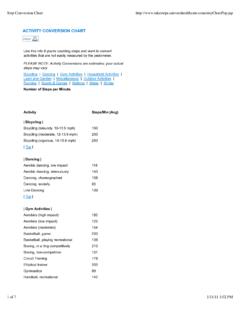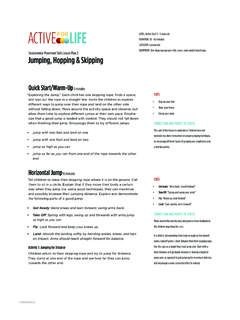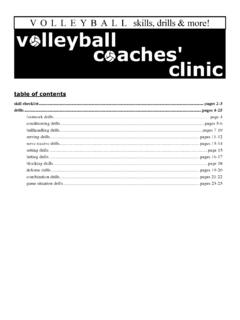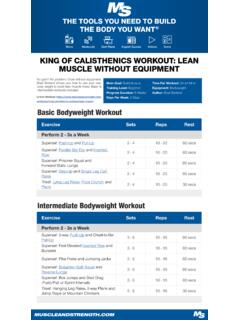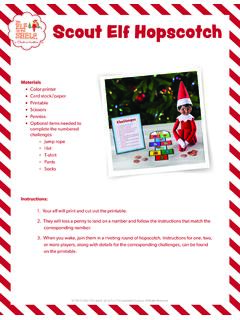Transcription of Rope Skipping - Coach Jackson's Pages
1 rope SkippingJumping rope will help to improve the athlete's rhythm and timing and acceleration of jumping leaps, start speed and quickness in small areas. Greater leg, ankle, knee and foot strength, better eye hand foot coordination, endurance and stability for throwing, blocking, shooting and holding onto or knocking ball away. Gripping strength for dribbling, holding on to, catching or throwing the jumping requires the athlete to remain on the balls of the feet, which also reinforces the Universal Athletic Position. This position of readiness, enables the athlete to move quickly in different directions on the field or of rope JumpingRope jumping takes everyone back to the basics, whether you jump for fitness or sports cross training.
2 Through practice, patience and perseverance you will learn and enjoy the many benefits of rope jumping . Aerobic & Anaerobic Capacity & Power Coordination Balance Agility Speed Quickness of Hands and Feet Explosiveness Weight Loss How To Develop Basic Jump rope Endurance (Capacity)Even the best jump rope equipment will yield minimum results without proper technique and a program tailored to address the needs of your sport or fitness :Consult your physician before starting a jump rope program. Children should be supervised at all times when jumping : Warm muscles before starting to jump by jogging in place or perform simulated jumping movements.
3 Then stretch entire body. Begin Phase:In the first two weeks, emphasis should be placed on technique, not speed. (See correct jump rope technique). rope jumping is a skilled movement, which requires proper timing and coordination of the rope swing with each jump. 1st Week: Practice the Basic Bounce Step and Alternate Footstep up to a total of 5 min. per day. Depending upon your current skill level, begin with as few as 1 to 5 or 5 to 25 jumps per jumping bout - stopping, resting and starting again, as you desire. Jump and rest in a 1 - 2 ratio (ex. jump 30 sec, rest 60 sec.). 2nd Week: As your technique and jumping capacity improves add 10 - 20 jumps to each jumping bout.
4 Jump and rest at a 1 - 1 ratio (ex. jump 60 sec., rest 60 sec.). By the end of the 2:nd week, you should be able to jump 100 - 300 jumps continuously without a Phase:3rd Week: After two weeks of training with the rope , you should work up to 5 min. of continuous jumping at 120 turns per min. to reach a level of basic fitness! Keep jumping 3 - 5 times per week. To advance, now work up to 10 min. of continuous jumping . It may take 3 - 6 weeks to attain this level. Keep jumping 3 - 5 times per week at 140 - 180turns per min. For variety apply the different sports training jumps (featured on the Magic of The rope Instructional Video).
5 Follow-through Phase: When you are able to perform 10 min. of continuous jumping varying the intensity level from 140 - 180 turns per min., you are then ready for the Buddy Lee's 5 and 10 min. Jump rope at you own pace, to avoid shin splints and sore calves. Stretch before during, and after each session, calves The Skill of JumpingYou must master the two basic skills, the Basic Bounce Step and the Alternate Foot Step before learning Buddy's Sports Training Jumps. Practice these two techniques 5 min. daily. Competitive athletes, should practice these techniques 10 - 15 min. twice daily. Remember, the focus is on the skill not on speed.
6 Stretch after each session, calves especially!Basic Bounce StepAlternate Foot Step1. Jump with feet together1. Swing rope around and jump over it with one foot. Now, swing rope around again and jump over it with the alternate foot. 2. Continue alternating feet (lifting knees slightly as if jogging in place).3. Do not kick feet back. It will cause them to catch on the Comparison Chart10 MIN rope jumping AT 120 TURNS/MIN. PRODUCES THE SAME CARDIOVASCULAR FITNESS AS:Cycling -- 2 miles in 6 min. Tennis -- 2 sets Running -- 1 mile in 12 -- 12 min.
7 Jogging -- 30 min. Handball -- 20 by Dr. Ken CooperRope Measurement1. Stand on center of rope with one foot2. Pull handles alongside to reach chest or underarmSurfaceI recommend the following surfaces because they provide equal rebound and impact absorption for the take off phase and landing of each jump. This helps avoid Wooden Floor- Rubberized Surface (Place rubber mat on concrete, tile or other hard surface)- Sport CourtThey generate quick rebounds and help develop speed, quickness and explosive avoid jumping on concrete, as it will increase the risk of lower body injuries.
8 Foot WearChoose a pair of cross trainer shoes with ample forefoot padding because jumping rope requires bouncing and balancing body weight on the balls of your feet. This is the opposite of running shoes, which provide the padding underneath the heels. Starting PositionPlace feet shoulder width apart with your body weight gently balanced on the balls of your feet. Rest the rope behind your calves. Practice, swinging the rope around your body to form a nice and even arc. When you have achieved this, it is time to add the "JUMP".Start your "JUMP" when the rope passes over your head. You are now timing the rope so that it will pass under your feet while you are "airborne".
9 Proper Hand Grip1. Grip handle with thumb and index finger on Wrap hand around handle. 3. Keep a comfortable but firm grip. 4. Make small circles with wristsChoosing A Speed RopeThe right equipment combined with a good program makes all the difference in receiving the maximum benefits from rope jumping . Train with a rope that allows you to best simulate the speed, agility and explosiveness required of your sport. A speed rope is designed specifically for both young and mature athletes at the proper weight and thickness to maximize the ropes aerodynamic properties. It is light weight, and responds to quick directional change and makes it easier to learn the basic techniques.
10 Speed ropes can comfortably turn at 180 - 300 RPM (revolutions per minute) for maximum training value, allowing you to train the way you want to perform in your sport or fitness Jump rope Technique1. Hold handles with a firm grip, elbows close to Make small circles with wrists while turning the Keep torso relaxed, head erect and look straight ahead to keep Jump only high enough to clear the rope , with light ankle knee During jumping , the rope should touch the surface Never sacrifice good jumping form for speed!Remember: the key to effective jumping is to be light on the balls of your JumpsBasic Bounce StepJump only high enough to clear the rope (one inch) and land lightly on the balls of your jumping not shownBegin with the rope in front of your feet.

